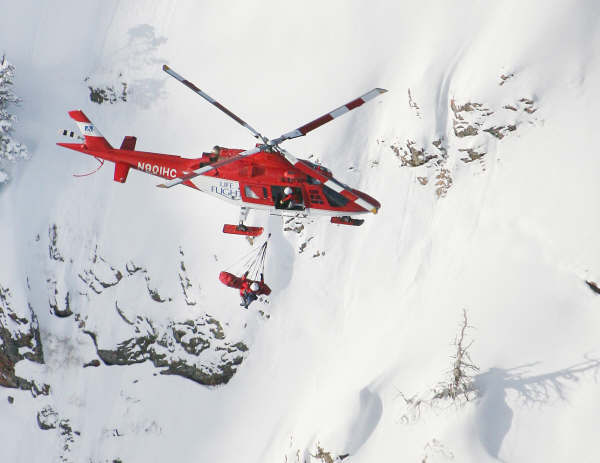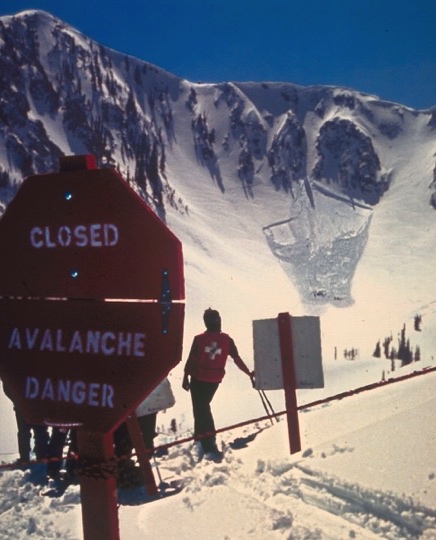Avalanche Incident Response
In Utah, we average slightly more than 3 avalanche fatalities each winter with many more close calls and accidents in the backcountry. You should be prepared to conduct your own rescue and be self-sufficient.
In the event of an Avalanche Emergency
-
Perform Companion Rescue. Time is of the essence. Survivability is drastically reduced after the victim has been buried for greater than 15 minutes. If you have enough resources, consider keeping one person on the ridge to call 911.
- If you need medical or transport assistance - Call 911 (At this time, texting 911 is only operational in some Utah counties). Consider a satellite type signaling device if you are in an area with poor cell phone service.
- State "This is a backcountry emergency, involving an avalanche accident."
- State your location.* Provide the dispatcher with your GPS Coordinates, elevation, and slope aspect if possible. Know how to get GPS off your phone.
- State number of patients and their status.
- Detail what help you are requesting.
- Patient Care
- Treat life threatening injuries (Airway, Breathing, Circulation, Hypothermia, etc)
- Be proactive making yourself and your patient(s) comfortable as rescues will take longer than anticipated.
Being prepared for a winter accident
-
Skills - Know CPR. Know how to improvise a hypothermia wrap. Take a Wilderness 1st Aid or Wilderness 1st Responder class. Take an avalanche class. Take an Avalanche Companion Rescue class.
-
Gear - Repair & 1st Aid Kit, Map/Compass/GPS, Headlamp with spare batteries, Fire starter, Bivy Sack/E-blanket, Shovel, Phone, Extra layers, extra cell phone batteries, whistle
-
Mindset - You need to have the mindset to be the primary rescuer in an avalanche incident. Never let your guard down. Pay attention. Make good decisions. Remember that risk is always inherent in mountain travel. Self rescue is best, but consider what happens if you get half way out and decide you need help. Nightfall, approaching storm, loss of cell phone service, etc. can complicate things. Help can always be turned around if not needed. Don't delay a serious medical emergency due to worries about cost. Salt Lake, Davis and Utah county don't charge for rescues, but you may be charged for medical transport to the hospital.

*Location - It is critical to state, "This is a backcountry rescue". The dispatcher in Salt Lake county may have a copy of the Wasatch Backcountry Ski Map. State the nearest backcountry location from the map and include drainage, subdrainage, and any other topographical landmark (ie-"We are in the Room of Doom in upper Mineral Fork of Big Cottonwood Canyon"). Otherwise provide the dispatcher with the drainage, subdrainage, nearby landmarks, GPS Coordinates, elevation, and slope aspect if possible.
Location with Enhanced 911 - This allows a wireless or mobile telephone to be located, using one of two approaches. One is to use some form of radiolocation from the cellular network (often triangulation between radio towers or something called TDOA - time difference of arrival, offering both angle and distance); the other is to use a GPS receiver built into the phone itself. Both approaches are described by the Radio resource location services protocol (LCS protocol). This is fairly new technology that has some success in the mountain environement but is not always 100% reliable. Complicating matters is that each provider (AT&T, Sprint, etc) offer slightly different means for geo-location.
Rescue Operations
Remember, this is your rescue. Each county's Sheriff's Office is authorized to conduct Search and Rescue. Authorized implies that they are tasked with implementing a plan but are not mandated to effect the rescue. An Incident Commander must consider the hazard to his/her rescue technicians before committing them to any situation. Be prepared to keep yourself and your patient comfortable as help may take longer than you might expect.
Potential Reasons that your rescue may be delayed:
-
Weather conditions at your location or elsewhere might delay or preclude a helicopter (wind, visibility, snow)
-
Helicopters or volunteer rescue crews may be busy with another rescue
-
Rescue teams can't find you. Make sure you are visible from the air if a helicopter is being used. At night a light source (headlamp) is critical.
-
If you are in dense trees consider moving an uninjured person to an open area or ridge if it can be done safely.
- A helicopter pilot may locate you and then leave to pick up backcountry rescue personnel and return
- Snow and weather conditions may slow rescuers approaching by ski or snowmobile. Remember, rescuers are volunteers. When they are called out, they need to leave work or home, drive to the staging point, and assemble at the command post as a team for briefing.
- Rescues outside Salt Lake County may require greater travel time and fewer available qualified rescue personnel
Resources that the sheriff's department incident commander may utlilize
County SAR Team - Each county has a dedicated volunteer search and rescue team.
Wasatch Backcountry Rescue - WBR is a 501c3 non-profit organization working in the Wasatch Mountains east of Salt Lake City, Utah, under the direction of the five Wasatch front County Sheriff's Search and Rescue divisions. Counties include Salt Lake, Summit, Weber, Wasatch and Utah County. They specialize in rapid response for avalanche rescue, winter related mountain rescue, and medical evacuation incidents using trained professionals and search and rescue dogs. Members of WBR include teams from professional mountain patrols and emergency care providers.
Powderbird Helicopter Skiing - Guide service based in Little Cottonwood Canyon and Park City area operating in the Wasatch from Ogden to Provo weather permitting. They have multiple helicopters commonly used for avalanche SAR. It is possible they will be the quickest response you will see. Powderbirds is not a medical ship.
Airmed - University of Utah air ambulance. Equipped with ALS flight nurse and flight medic. Based in Salt Lake City and Park City. May land in unimproved (backcountry) terrain at pilot's discretion.
Lifeflight - Intermountain Health Care air ambulance. Equipped with ALS flight nurse and flight medic. Based in Ogden, Salt Lake, City, and Provo. Helicopter may offer "Hoist-extraction" capabilities.
Department of Public Safety helicopter - hoist extraction capable, but not a medical ship
National Guard helicopter - for night and bad weather missions - long spin up time

If you trigger or see an avalanche adjacent to the road or one of the ski areas and are sure no one was caught in the avalanche, call the nearest mountain dispatch and alert them to the situation, this will allow SAR teams to stand down, preventing them from being subjected to unnecessary hazard.
Salt Lake and Park City – Alta Central- (801-742-2033)
Canyons Resort/PCMR Dispatch- (435 -615-1911)
Brighton Resort Dispatch- (801-891-2339)
Solitude Mountain Dispatch- (801-536-5753)
Snowbasin Resort Dispatch-(801-620-1017)
Powder Mountain Dispatch- (801-745-3772 ext 3).
Sundance Dispatch- (801-223-4150)
A good interview with Denali Ranger and SLC Intermountain Life Flight paramedic Dave Weber.






